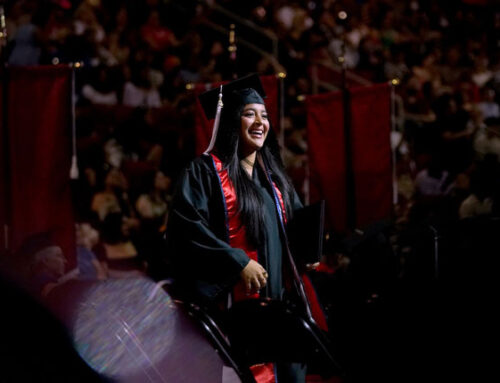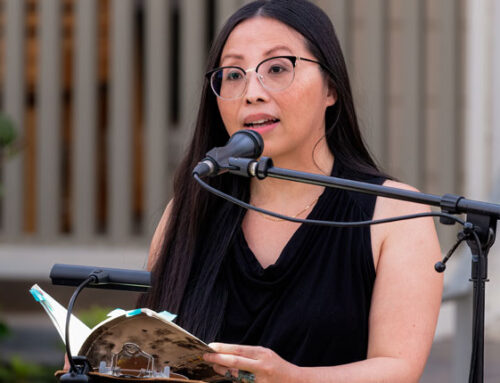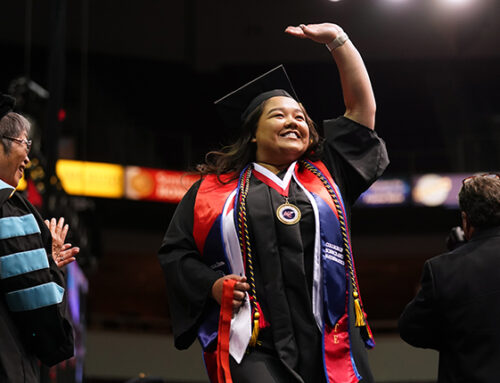President John D. Welty opened the academic year at California State University, Fresno on Wednesday, Aug. 17, with a look into the university’s second century that will include a “new normal” of reduced state funding.
The 2011-12 academic year is Fresno State’s 101th year serving higher education needs in Central California. The university opened its doors on Sept. 11, 1911 as Fresno State Normal School, dedicated to training teachers for the fast-growing San Joaquin Valley.
Welty asked faculty and staff to continue their excellent work – despite state budget cutbacks –to serve students today and in the future. “The work we do today is crucial to keeping Fresno State strong for tomorrow’s students,” he said at the annual Academic Assembly gathering of faculty.
He also took to task the state’s citizens and Legislature who have reneged on California’s commitment to public higher education.
“I am extremely disappointed that our state has chosen to turn its back on higher education,” Welty said. “As I have said before, it is ironic and disheartening that California citizens and legislators, who themselves benefitted from a free or low-cost public higher education in years past, are unwilling to sacrifice and support today’s students who will lead our state in the years ahead.”
Fresno State expects 21,655 students this fall, approximately the same number as last year.
Despite changes and fluctuations in enrollment targets dictated by state, funding reductions and staff cuts, the university has managed to keep enrollment from dropping significantly, preserving opportunities for students.
Welty said that Fresno State is operating with about 300 fewer employees than three years ago – reduced from 2,747 to 2,460 employees.
Welty reiterated from previous addresses to the campus that the one-time federal stimulus dollars that helped academics will be gone, so Academic Affairs now faces a base budget gap that could exceed $2 million. Carryover funds are being used in the short term while a permanent solution is achieved. An academic task force is examining approaches to closing this funding gap long term and will offer recommendations to Provost William A. Covino in the coming weeks.
Another area of concern is that the budget adopted by the Legislature calls for an additional $100 million reduction to the California State University system in state revenues do not achieve a certain level.
“I am not optimistic that the state will achieve the projected revenue levels,” Welty said. “Thus, we may need to make additional mid-year reductions. I am working with our campus leadership to try to minimize the impact for the current year, but another $100 million reduction to the CSU system will significantly impact our ability to serve students in 2012-13.”
Welty said there is good news to celebrate, including:
- Professor Emeritus of English Philip Levine has been named Poet Laureate of the United State.
- The Campaign for Fresno State, a $200 million comprehensive fund-raising campaign, has raised $168.7 million to date, and the positive impacts are felt throughout campus, with more student scholarships, establishment of academic institutes and programs, and building enhancements.
- A donation will allow a new Rue and Gwen Gibson Farm Market to be constructed starting next spring. It will be located just south of the current location on Chestnut Avenue.
- Renovation work was done over the summer in all 132 campus classroom, including a “head-to-toe” revamp in the Social Science Building. New technology was installed in many rooms. Ongoing renovation work will continue this year.
- A Faculty Office Building project will get $9.7 million in bond money, once the state is able to sell bonds. The building will be located north of the North Gym and will have faculty offices, lockers and labs to support nursing, physical therapy and athletic programs.
- The Aquatics Center nearing completion will be used for academic purposes by the Department of Kinesiology and by Athletics for the swimming and diving team.
- For the second consecutive year, the Richter Center for Community Engagement and Service-Learning has coordinated over 1 million volunteer hours of service to our region. The 1,053,481 hours, most of them contributed by about 14,000 students, have an estimated economic impact of just over $26 million, based on national philanthropic standards.
- Efforts to boost student success are paying off. The first-to-second-year retention rate of 86 percent and the second-to-third-year retention rate of close to 80 percent represent records for the university.
- There is continuing improvement in the academic achievements of student-athletes. Academic Progress Rates continue to climb and all sports exceed the NCAA threshold. The latest graduation report submitted to the NCAA is well above 50 percent and the GPA is over 3.0 for student-athletes. Both surpass universitywide student marks.
- Efforts to streamline work processes are bearing fruit. For example, a campus project group examined how work orders are filled and recommended ways to streamline the process from 29 days to 12 days.
Welty said the campus will continue to strengthen its commitment and proactive work to promote diversity. A new Diversity Matters @ Fresno State website was created and Welty has appointed a President’s Commission on Human Relations and Equity to develop a comprehensive Diversity Plan aligned with the university’s new Strategic Plan for Excellence.
As the commission works to develop the plan, there will be ample opportunity for campus and external community members to hear of progress and provide ongoing feedback and input into the process, Welty said.
Priority also will be given to internationalization efforts. A task force will consider the steps needed, with initial efforts aimed at increasing the number of international students.
Also this year, the campus will begin accepting students for the fall 2012 inaugural year of two new doctoral programs, in Physical Therapy and Nursing Practice. These self-supporting programs will allow Fresno State to educate professionals in two crucial health fields.
Related link:




